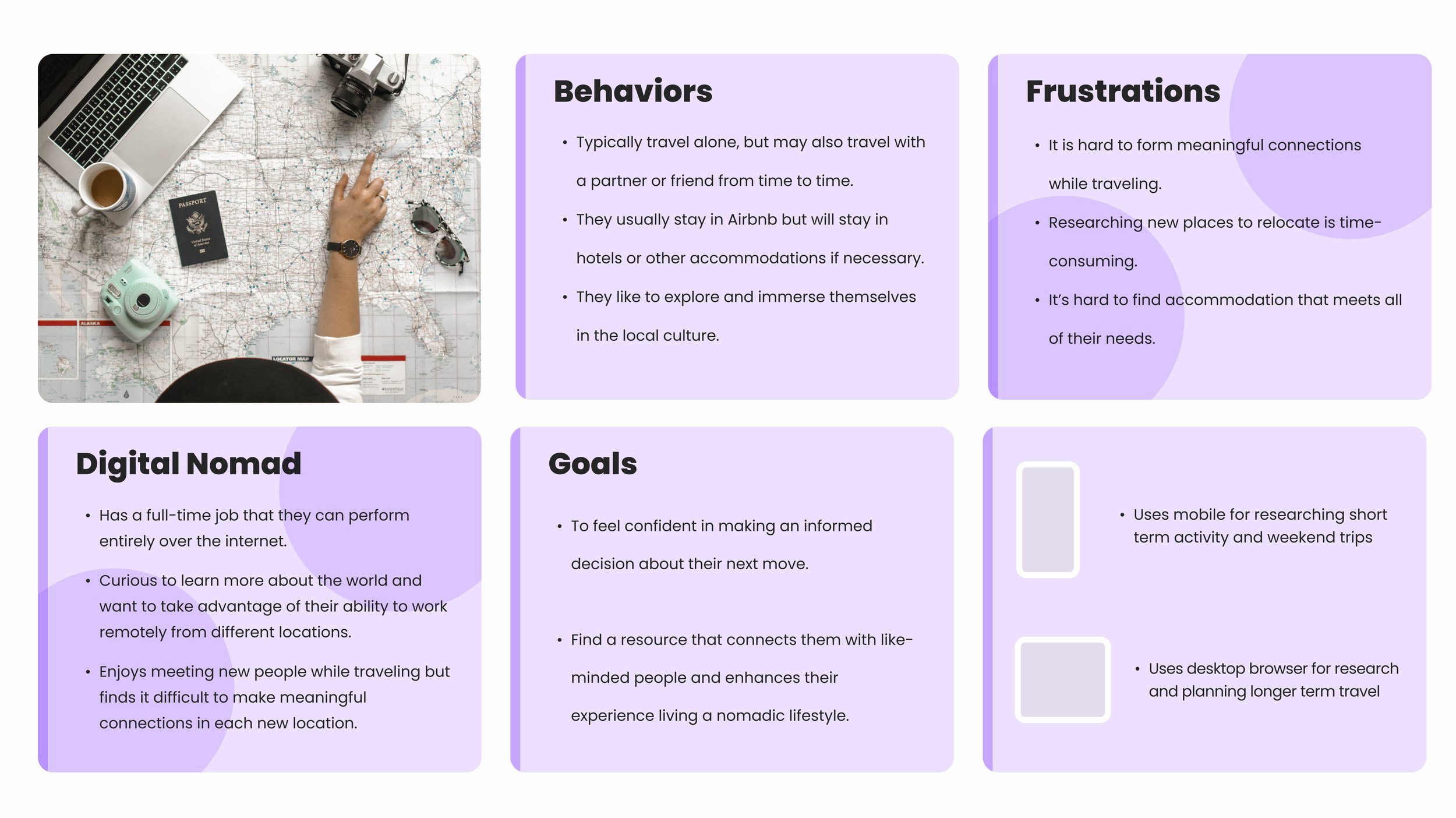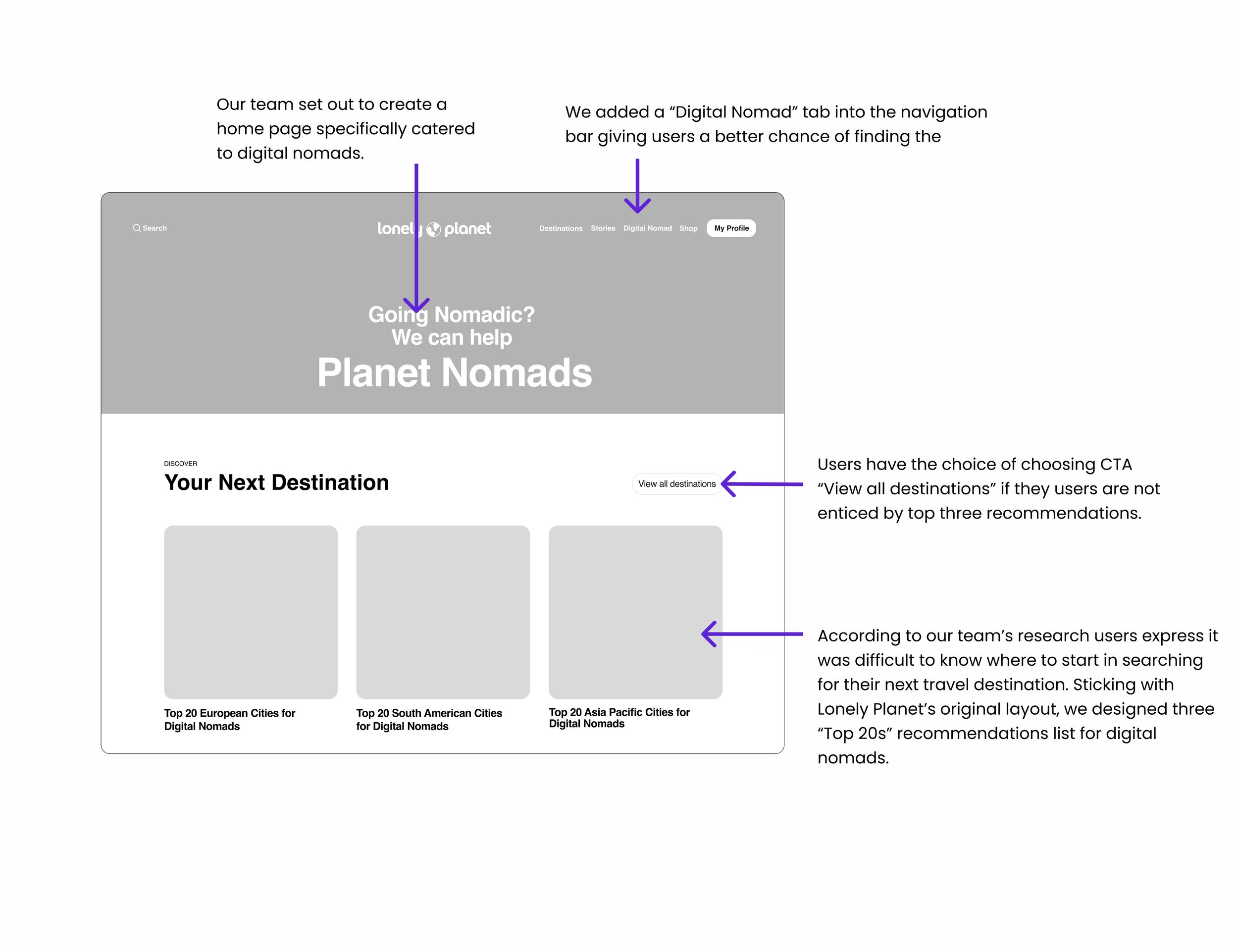
Client:
When the founders of Lonely Planet, Tony and Maureen Wheeler created their first guidebook for travelers after having traveled throughout Asia themselves. Since then Lonely Planet has been dedicated to travelers, giving ideas and information to travelers with trusted content for print and digital from the experts who have visited every destination.
Lonely Planet believes that everyone should experience the beauty of traveling regardless of your background. They are here to empower and guide travelers to make informed decisions about traveling.
Lonely Planet’s Mission: We believe that travel is for everyone. It helps us learn about ourselves and the world around us. Our goal is to help more people from diverse backgrounds experience the joy of exploration. Because we believe this builds a kinder, more inclusive, more open minded world.
Project Type:
New Feature Concept for a Responsive Website
Duration:
This project was two weeks in duration.
Role + Responsibilities:
Researching, Persona, Problem Statement, HMWs, Sketches and Wireframing, Usability testing, Designing, Reflection
Group Members
Jenny Pham UX Designer
Lorenza Gerber UX Designer
Rebecca Lothen UX Designer
Kait Tripp-Addison UX Designer
“A Digital Nomad is someone who preforms their occupation online while traveling.”
Challenge: Due to the Covid-19 pandemic, there had been an increase in remote work. Giving some remote workers an opportunity to work from anywhere they choose, coining the term “Digital Nomad,” who is someone who works over the internet and travels at the same time.
Lonely planet would like to assist digital nomads create a more enjoyable lifestyle by connecting the wonders of travel and work by providing information and guides specifically designed for digital nomads.
Our team’s challenge was to create and design guides and add features that give recommendations on where to travel to and help digital nomads in choosing their next destination and adventures within the existing Lonely Planet website and providing information for the best places to work from.
Solution: Given the original project goals, our team conducted User surveys and User interviews. Then a Comparative and competitive Analysis with a journey map. After, our team came up with three strategies to better assist digital Nomads on the new featured section of the Lonely Planet website called “Planets Nomads.”
The first is to provide digital nomads opportunities to research new destinations to live and work from.
The second is to give digital nomads the chance to post questions they may have to the community that they are traveling to and to find the best neighborhoods in a city to stay in.
The third is to create a forum to allow nomads to exchange tips with each other while traveling.
We also simplified the navigation flow of the Lonely Planet’s website to help better navigate digital nomads to our newly designed features of Planet Nomads.
“Survey results are in!”
To find participants for our survey an announcement was created geared towards digital nomads on forums such as Slack and on Reddit as well as directly reaching out to friends who travel and work remotely. Our team wanted to get a baseline for a general understanding of digital nomad’s lives. 35 participants from across the world participated in the survey.
Q1
Q2
Q3
Q4
Q5
Q6
“Keep Calm & Travel On”
User Interviews: Digital Nomads who participated in the survey were asked at the end of the survey if they would like to move forward with a user interview. From there 10 participants were interviewed. Our team wanted to further our research to wanted to find out
The pain points and journey of a digital nomad’s lifestyle.
To better understand and support the specific needs of a digital nomad.
To better understand how digital nomads explore travel destinations.
A comparative and competitive analysis was conducted with big name travel companies such as Fodors, Airbnb and Kayak.
Fodor’s Travel had guide books and a journalistic presentation style. Fodors also had an explore Fodors forum.
Airbnb started as a purpose driven travel platform and then launched a secondary product to meet changing customer needs. Airbnb Experiences is where guest can book activities during there stay.
Kayak Work from Wherever Guide is a separate section from Kayak that helps digital nomads choose the right designation to work and travel to.
“A Retrospective Point of View”
I created a retrospective journey to have better insights on creating the problem statement and How might we’s.
Scenario:
Dana is a digital nomad working in Dublin. She is searching for her next travel destination that has a quiet place to work with reliable wifi and a activity to do while there.
Expectations:
A place for reliable wifi to work at
Information about the destination (that focuses on helping digital nomads)
A destination with fun activites
Click on image for larger view
“It is about shaping work around your life, not shaping your life around work.”
User Persona:
My team and I created a User Persona to help assist with creating a problem statement.
“What is the Problem?”
Problem Statement:
Lonely Planet offers all types of travelers curated guides to explore different countries and the activities within them. Lonely Planet believes that traveling gives humans powerful tools and resources to create more inclusive and kindhearted communities. They envisage a way to assist digital nomads curate their travel experiences.
Digital nomads need a way to find valuable insights about the places they want to travel to, that help them navigate accommodations, activities, budgeting, and work while being a part of a community. However, there are no websites that specialize in guides for digital nomads that could help them travel and explore within their constraints and build a sense of community.
“And How Might We...?”
How might we: inspire digital nomads to immerse themselves in the culture of each location as they travel while working?
How might we: equip digital nomads with resources that allow them to connect with others and foster a sense of community?
How might we: support digital nomads planning their travel in ways that will equip them to successfully work while they travel the world?
“Lets Sort it Out!”
A card sort was conducted to gain insights on how users would group/categorize different types of activities that are offered via Lonely Planet in each city. Our team decided to go this route because we felt that Lonely Planet’s preexisting “Sights” and “Attractions” naming conventions were both too broad to be useful and would not be appealing for digital nomads because they value immersive travel over tourist experiences. 35% of participants were able to agree and group together seven of the following groups. While 82% of participants agreed on broader categories of dining, shopping, landmarks and exploring.
Food & Drinks
Parks
Entertainment
Museums
Religious Sites
Historical Sites
Shopping
“Low-fi Prototype!”
“Lets Test it Out!”
Five participants from General Assembly Ux Design School and various family and friends participated in the Usability test.
Task 1: Please show me how you would find the best rated city for remote workers who want to live abroad in Europe. Save/bookmark this city page.
Task 2: Show me how you would find an article on best neighborhoods in Lisbon. Now that you have that open, could you please show me where you would find comments from the community, and then post a question about good coffee shops to work.
Usability testing results suggest that-
5 out of 5 Users could not find Top Destinations tab and did not expect it to be under Digital Nomads
3 out of 5 users struggled to find Best Neighborhoods card
2 of 5 users struggled to find Tips
Usability Synthesis suggest that
Users plan their trips mostly through desktop but once they want to find out information about the place they are at, they usually use their phones a lot.
Users enjoy the overall UI design and feel of the page.
The majority of users were able to complete the task at hand, but the areas that caused the most confusion were: the header and the navigation to get to certain pages.
Check out the Hi-Fi Prototype
“Where to Next?”
For our next steps, we would like to explore even deeper in the community aspects of what a digital nomad would prefer specifically when it comes to what resources would be most helpful. We would like to also incorporate a table or a way to explain how we came to our ratings and information about locations for Digital nomads. Due to the time constraint of this project another next step we would explore is designing features for mobile use.






















